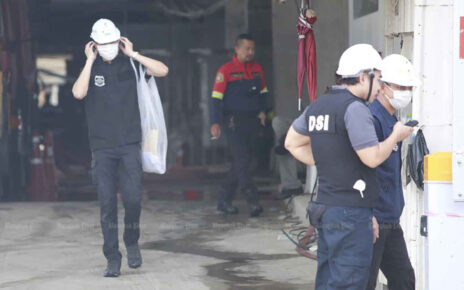A large number of students at a Prachin Buri province secondary school were taken to hospital on Monday afternoon after consuming a school lunch, reporting acute diarrhoea and vomiting. The incident prompted an immediate response from medical teams and health officials, who launched a rapid assessment of the meal served in the school canteen and ordered laboratory testing to determine the cause. While some students received hospital care, others with milder symptoms were treated at the school infirmary as the investigation began. Officials emphasized that swift action is underway to prevent a recurrence and to reassure concerned families and staff.
Incident Overview and Timeline
Nineteen students from a Prachin Buri province secondary school were rushed to hospitals after experiencing rapid-onset gastrointestinal symptoms, including dizziness, nausea, severe diarrhoea, and vomiting, following the lunch provided by the school. At approximately 2:30 p.m., emergency services at Chao Phraya Abhaibhubejhr Hospital received a distress call from the school, setting in motion an immediate medical response. A medical team was dispatched to the campus with the aim of assessing the students on-site and stabilising those in urgent need of care.
Upon arrival, the medical team reported observing a cluster of students displaying signs of dehydration and discomfort consistent with acute gastroenteritis. In the wake of these findings, a decision was made to transport the most severely affected students to hospital facilities for thorough evaluation and treatment. A total of twelve students were transported to Chao Phraya Abhaibhubejhr Hospital, while seven others were admitted to Fort Chakrapong Hospital. The remaining students with milder symptoms were treated within the school infirmary, where ongoing observation and basic care could be provided in a familiar environment.
All of the affected students were reported to have eaten the chicken rice lunch that had been served in the school canteen. This common dietary link among the cases prompted officials to consider the possibility of foodborne illness stemming from the meal, though the exact source remained under investigation at that time. The correlation between the lunch and the onset of symptoms was a critical factor driving the investigation and the subsequent testing plan, as authorities sought to identify whether a contaminant in the prepared meal could account for the outbreak.
In the days that followed, officials from the Prachinburi Provincial Public Health Office indicated that the food may have been contaminated, a possibility that would require confirmed laboratory evidence. To this end, food samples were collected for laboratory testing, and investigators proceeded with a comprehensive examination of the meal’s preparation, storage, and distribution processes to determine the outbreak’s source. The aim was to establish whether a pathogen or other contaminant was responsible and to determine if lapses in food safety practices contributed to the incident.
The incident triggered concerns among parents, teachers, and school administrators, who called for a thorough review of food safety protocols within the school environment. In response, public health and school officials pledged to conduct a rigorous evaluation of kitchen hygiene, cooking procedures, ingredient sourcing, and handling practices. The overarching goal was to identify weaknesses, implement corrective measures, and prevent future occurrences. Officials also reassured parents that swift action was being taken and that ongoing monitoring and communication would be prioritized to curb any recurrence and to restore confidence in the school’s food safety culture.
Medical Response, Care Standards, and Patient Outcomes
The medical response to the outbreak involved swift triage, stabilization, and admission decisions designed to ensure the well-being of the affected students. Hospital teams implemented standard emergency protocols for gastroenteritis, prioritising rapid assessment of vital signs, hydration status, and symptom severity. This approach enables clinicians to determine which patients require inpatient observation, intravenous fluids, antiemetic therapy, antidiarrheal medications when appropriate, and close monitoring for potential complications such as dehydration or electrolyte imbalance.
Injured students presenting with severe dehydration or persistent vomiting were prioritised for hospital admission to ensure timely fluid resuscitation and electrolyte correction. Those with moderate symptoms were monitored in hospital wards or, in some cases, retained in the school infirmary for closer observation. The triage process emphasized careful reassessment at defined intervals to detect any deterioration in condition, allowing clinicians to escalate care if necessary. Throughout the clinical course, healthcare teams ensured that pain management, anti-nausea treatment, and oral or IV hydration were tailored to each patient’s needs and tolerability.
The psychological and emotional needs of students were also considered as part of the care plan. A school-based health liaison or guidance counselor often plays a role in supporting students and families during such events, helping to contextualise the situation, reducing anxiety, and facilitating communication between the school, families, and health authorities. In this incident, the swift transfer of twelve students to a hospital setting and seven to another facility demonstrates a widely adopted practice of distributing patients according to severity to optimise care capacity and ensure appropriate monitoring.
As the investigation progressed, hospital teams documented each patient’s clinical course, including time of onset of symptoms, time of presentation to care, treatments administered, response to interventions, and any changes in hydration status. This data informs both the immediate clinical management and the broader epidemiological assessment of the outbreak. While some students recovered rapidly, others required closer observation to ensure there were no lingering symptoms or complications. The hospital teams maintained open channels of communication with school officials and families, providing updates on patient status and anticipated timelines for discharge where appropriate.
Overall, the medical response reflected a coordinated approach between hospital staff, school administrators, and public health authorities. The strategy emphasised rapid assessment, timely treatment, and careful monitoring to mitigate any adverse outcomes. The collaboration aimed to stabilise affected students, prevent further deterioration, and support families during a period of concern and uncertainty. As laboratory results emerged, clinicians would be able to correlate specific findings with clinical presentations, enabling more precise guidance on management and prevention.
Food Safety Investigation: Sampling, Testing, and Process Review
Central to the investigation was the collection and analysis of food samples from the implicated lunch. Officials from the health department emphasised that laboratory testing would be essential to determine if a contaminant or pathogen was present in the chicken rice served at the school canteen. The collection process would typically involve securing representative portions of the meal, including the chicken rice dish, accompanying condiments or sides, preparation utensils, and any other items that may have contributed to the contamination risk. Ensuring proper chain of custody is a critical component of such investigations to guarantee the integrity of samples from collection to analysis.
Testing would involve a range of approaches designed to identify potential pathogens, toxins, or spoilage indicators. Microbiological analyses could detect bacteria associated with foodborne illness, such as Salmonella, Staphylococcus aureus, Escherichia coli, or other organisms commonly linked to contaminated or improperly handled foods. In addition, chemical testing might screen for toxins or contaminants that could lead to similar clinical presentations. The results of these tests would guide the investigation toward a probable source, whether it be ingredients, cooking practices, storage temperatures, cross-contamination, or other operational factors within the school kitchen or canteen.
Alongside laboratory work, investigators would conduct a comprehensive review of the meal’s preparation and service chain. This would involve interviewing kitchen staff, reviewing standard operating procedures for cooking and holding hot foods, and evaluating the temperature control and hygiene practices observed during food handling. Attention would also be given to sourcing practices for chicken, rice, and accompanying items, looking for potential lapses in supplier controls, stocking times, or biosecurity measures that could contribute to contamination risks. Environmental assessments, including cleanliness of the kitchen, sanitizer use, handwashing facilities, and utensil sanitation, would be part of the broader review.
Communication strategies would accompany the technical work, ensuring that parents and school staff understood the investigation’s scope and the steps being taken to ensure safety. Officials would typically provide regular updates on the status of the investigation, any immediate precautions for the school, and expected timelines for results. The objective of these investigative steps is to identify the cause, implement corrective measures, and reduce the likelihood of future incidents while preserving public trust through transparent actions and proactive risk management.
The broader implications of the investigation extend to potential policy considerations and procedural improvements across schools serving meals. Should a fault be found in the kitchen processes, corrective actions would likely include enhanced training for food-handling staff, stricter adherence to temperature controls for cooked foods, and reinforced monitoring of the supply chain for ingredients. These measures would contribute to ongoing risk reduction and to establishing a more resilient food safety culture within the school environment.
School and Public Health Response: Protocols, Training, and Safety Improvements
In light of the incident, the Prachin Buri Provincial Public Health Office and the school administration initiated a joint review of current food safety protocols to determine where improvements could be made. Such reviews typically examine the entire food service continuum, from procurement and storage of ingredients to preparation, cooking, hot holding, and serving procedures. They also assess the frequency and quality of health inspections, staff training programs, and the availability of clean water and proper sanitation facilities for both kitchen personnel and students.
Key components of the response would include reinforcement of hygiene education among kitchen workers, with an emphasis on thorough handwashing, proper use of protective gear, and avoiding cross-contamination between raw and cooked foods. Additional measures could involve the implementation of more stringent temperature controls, ensuring cooked chicken and rice are held at safe temperatures prior to service, and maintaining strict time-temperature guidelines during food service. Periodic audits by health inspectors would likely be scheduled to verify compliance with established standards and to identify any deviations before they become risk factors for illness.
The school atmosphere would also benefit from enhanced oversight and risk reduction measures. This could entail more robust daily pre-service checks of the kitchen, clearer labeling of ingredients, and stricter monitoring of portions used in meals served to students. In some cases, schools might consider temporarily adjusting or clarifying menus during investigations to reduce risk while maintaining a balanced, nutritious meal plan for students. Any changes implemented would be designed to protect students while the investigation proceeds, and to reassure parents and guardians about the safety of school meals.
Amid these operational improvements, health authorities would likely place emphasis on transparent communication with families. They would share information about the investigation’s progress, reinforce the importance of reporting any symptoms promptly, and provide guidance on when to seek medical attention. The overall aim is to contribute to a climate of confidence in school meal safety by demonstrating accountability and a proactive posture toward risk mitigation. The coordinated approach between public health officials and the school would be essential to ensure effective implementation of recommended practices and to sustain public trust during and after the investigation.
Community Impact, Parent Assurance, and Information Channels
The incident understandably generated concern among parents and school staff, who sought timely and accurate information about what happened and what steps were being taken to protect students. In such circumstances, authorities typically deploy a combination of on-site briefings, written notices, and routine updates through official channels to keep families informed while avoiding the spread of misinformation. Clear communication about the nature of the lunch that was served, the symptoms observed, and the actions taken by authorities is critical to maintaining confidence and reducing anxiety among students and their families.
Parents emphasized the need for robust food safety measures, both now and in the future, to prevent recurrence. The school administration, together with health officials, would likely outline a plan detailing steps being undertaken to strengthen kitchen hygiene, improve ingredient handling, and ensure rigorous adherence to food safety standards. They would also address any concerns about potential disruptions to school meal schedules, whether temporary changes are needed, and what support services are available to students during the investigation.
Community outreach would involve not only parents but also teachers, school staff, and local health professionals. Open lines of communication can help demystify the investigation process, while demonstrations or information sessions about safe food handling practices may be offered to staff and students. In the wake of such events, schools often partner with local health departments to deliver educational resources on food safety, hygiene, and the importance of immediate reporting of symptoms. This collaborative approach helps build lasting awareness of risk factors and fosters a culture of safety within the school community.
From a broader perspective, the incident highlights the vital role of routine risk assessments in school cafeterias and the ongoing need for vigilance in food service operations. Even when a problem is isolated, it can trigger a chain of improvements that benefits the entire student population and staff. As investigations proceed and outcomes become clearer, the school and health authorities typically publish findings and recommendations that can inform practices in other schools facing similar challenges. The ultimate objective is to prevent future incidents and to ensure that school meals remain a reliable source of nutrition for students without compromising their health.
Public Health Investigation, Risk Mitigation, and Future Prevention
The investigation surrounding the lunch-related illness is a critical component of a broader public health strategy aimed at identifying risks, mitigating potential harms, and preventing similar incidents in the future. Public health officials routinely engage in rigorous data collection, analysis, and cross-sector collaboration to understand the factors that contributed to the outbreak. This includes evaluating the food handling chain, environmental conditions in the kitchen, storage practices, and adherence to established food safety protocols.
Further risk assessment involves identifying any gaps in staff training, equipment maintenance, and adherence to hygiene standards. If deficiencies are uncovered, targeted interventions are implemented to address them, such as enhanced training programs, upgrades to sanitation equipment, or revisions to standard operating procedures. The objective is not only to resolve the current issue but also to build resilience against future hazards associated with school meals.
In parallel with laboratory testing and process reviews, the public health investigation would consider the potential implications for students’ health and well-being beyond the immediate episode. This could include follow-up health monitoring for affected students, guidance on hydration and nutrition during recovery, and recommendations for parents on signs and symptoms that warrant medical attention if they reoccur. The coordination among hospitals, the school, and public health authorities is essential to ensure that students receive appropriate aftercare while the community gains clarity about the incident’s causes and preventive measures.
The investigation’s findings, once confirmed, would inform a set of concrete recommendations designed to enhance food safety across school settings. These recommendations typically address procurement practices, storage and preparation methods, cooking temperatures, cross-contamination controls, and routine health inspections. They may also lead to the implementation of standardized checklists for kitchen operations, clearer accountability for food safety audits, and more frequent training sessions for cafeteria staff. The long-term aim is to reduce the likelihood of similar foodborne illness events and to strengthen the overall safety culture within schools.
Operational Improvements and Long-Term Implications for School Food Safety
As authorities work toward a comprehensive understanding of the event, it is plausible that the school and the public health office will implement a range of operational improvements designed to heighten food safety and reduce risk on a daily basis. These improvements could include the introduction of enhanced supplier verification processes to ensure ingredient quality and safety, increased frequency of kitchen sanitation protocols, and tighter controls over food preparation and holding times. By instituting more robust oversight, schools can mitigate the risk of contaminated meals reaching students and provide additional safeguards in the event of future supply chain disruptions.
Additionally, the incident may catalyse the adoption of more rigorous record-keeping practices within the school cafeteria. Detailed logs for meal preparation, cooking temperatures, holding times, and staff shifts are valuable tools for tracing issues quickly and accurately should problems arise again. Such documentation supports traceability and accountability, enabling health authorities to track the source of any contamination and determine whether corrective actions have been effectively implemented.
In the broader context, school meal programs nationwide may view this incident as a case study highlighting the importance of preparedness and proactive risk reduction. Lessons learned from this event can inform ongoing policy discussions about resource allocation for school kitchens, staff training investments, and infrastructural improvements. For example, schools might explore enhancing ventilation, upgrading food storage facilities, or implementing technology-assisted monitoring systems that provide real-time alerts when temperatures fall outside safe ranges. While changes vary by school size and capacity, the overarching objective remains consistent: to protect student health while providing reliable, nutritious meals.
Community trust is another essential long-term consideration. Transparent communication about outcomes, corrective actions, and progress toward safety goals can help maintain confidence among families and the broader community. Public health agencies and schools may coordinate ongoing education campaigns about food safety, encouraging student engagement and ownership of safe food handling practices. By fostering a collaborative and informed community, authorities can promote sustained improvements that extend beyond the specific incident and contribute to safer school environments nationwide or regionally.
Documentation, Accountability, and Future-Ready Preparedness
Documenting the sequence of events, the actions taken, and the outcomes of the investigation is critical for accountability and for informing future preparedness. Comprehensive documentation allows for retrospective analysis, enabling health officials and school leaders to review what occurred, evaluate the effectiveness of the response, and identify gaps that require attention. Such records are also valuable for communicating with families, sharing evidence-backed findings, and supporting ongoing improvements in safety protocols.
In terms of accountability, it is important that all parties involved—the school administration, food service staff, and health authorities—engage in constructive assessments of their respective roles. Transparent acknowledgment of any operational shortcomings, coupled with concrete corrective actions, can reinforce public trust and demonstrate a commitment to continuous improvement. The collaborative process helps ensure that lessons learned translate into practical, sustained changes that reduce risk and improve safety outcomes for students.
Looking forward, schools may incorporate scenario-based training that simulates foodborne illness outbreaks tied to school meals. These drills can enhance readiness by practicing rapid response, effective communication with families, and coordination among medical facilities and public health offices. Regular preparation exercises can build muscle memory among staff, ensuring that when real incidents occur, responses are swift, coordinated, and grounded in established protocols. The ultimate aim is to minimize disruption to education while maximizing student safety and well-being when such health events arise.
Conclusion
The Prachin Buri incident involving nineteen students who fell ill after consuming a school lunch underscores the critical role of rapid medical response, vigilant food safety practices, and transparent public health investigations in safeguarding student health. The linkage of symptoms to the chicken rice meal prompted immediate hospital referrals, while the collection of food samples and ongoing laboratory testing aimed to identify the precise cause. In parallel, officials reviewed kitchen hygiene, handling procedures, and training to strengthen preventive measures and reduce the risk of recurrence.
The proportional allocation of patients to hospital care, with twelve treated at Chao Phraya Abhaibhubejhr Hospital and seven at Fort Chakrapong Hospital, reflects a structured approach to prioritising care based on severity, ensuring that those most in need receive appropriate attention while others receive effective on-site management. Officials from the Prachinburi Provincial Public Health Office indicated that contamination remains a plausible hypothesis, and the ongoing laboratory analyses, alongside a comprehensive process audit of the meal’s preparation and service, are central to drawing definitive conclusions.
Parents and school staff have expressed understandable concern, and a coordinated response is underway to reinforce food safety protocols and restore confidence in school meals. The combined efforts of health authorities and the school aim to ensure safer meals, more rigorous kitchen practices, and clearer communication with families as investigations progress and corrective actions are implemented. The incident serves as a reminder of the importance of continuous improvement in food safety within school environments, with a focus on prevention, rapid response, and sustained vigilance to protect the health and well-being of students.



